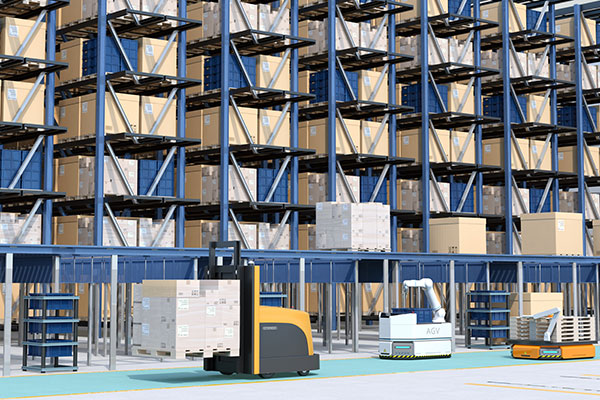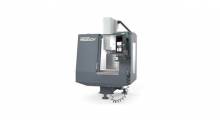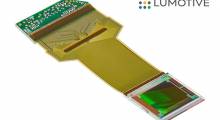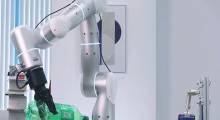Focused on developing fast, efficient fulfillment operations that meet the needs of today’s e-commerce customer, more companies are investing in robotic solutions that help them meet those demands.
By providing an automated alternative to traditional picking and packing systems, robots are also helping companies offset a scarcity of skilled labor and an unemployment rate that’s hovering at historically low rates.
Highly dynamic, unstructured environments, warehouses and distribution centers have historically posed challenges too great for robotics to tackle. But thanks to key technology advances, a new generation of smart, increasingly capable robotics solutions have emerged as key productivity enablers in the DC.
But it’s not enough to simply buy a robot and hope that it solves your fulfillment problems. You also can’t just invest in a few pieces of automated equipment with the goal of ramping up your current operations and meeting your most demanding customers’ needs. Not an end-all, robotics is just one part of a complete, end-to-end solution that incorporates numerous different elements.
Got labor and resource challenges?
In a world where nearly 30% of the workforce is age 55 or older, and where hiring new workers costs 25% to 150% of an employee’s annual salary, robotics presents a cutting-edge solution to an age-old problem. In 2017 alone, nearly 600,000 warehouse jobs were unfulfilled in an industry where growth outpaces the labor pool by a 6:1 ratio.
Warehouses and DCs have also become very expensive to run. In the typical warehouse, 42% of resources go to picking, 17% to stocking, and 11% to indirect labor. An additional 11% are spent on replenishment and 6% for packing/checking. A key productivity enabler, robotics is becoming an increasingly vital aspect of handling growing order volumes while also overcoming labor availability and resourcing challenges.
Meanwhile, customers demand a seamless shopping experience: one-day delivery, lower prices and maximum convenience. The culmination of rising consumer expectations, a shrinking labor pool and high order volumes are rapidly driving demand for more automation in warehouses and DCs worldwide.
The robotics revolution has arrived
We’re in the midst a robotics revolution, yet 80% of warehouses are still manually operated, meaning they have no automation support, according to a recent DHL Trend research report. This is about to change. A tight labor market driven by the uptick in e-commerce (analysts predict that global e-commerce sales will double by 2021, reaching a staggering $4.5 trillion annually) has created a situation ripe for automation.
The full spectrum of robotics technology offers tremendous potential for the DC, and is constantly expanding and evolving to enable next-generation efficiencies. Adaptable, collaborative robotic solutions known as “cobots” are designed to work alongside humans, handling transportation, storage and retrieval tasks, and more.
Technological advances in perception, processing power, and gripping have also expanded robotic capabilities for the DC. Advances in 3D vision technology are expediting and improving unloading and picking tasks, both of which consume large amounts of labor and resources in the typical warehouse.

Making the right choice
With a wide array of robotics options to select from, making the right choice for your operation is an important first step down the automation path. And because much of the data for these applications doesn’t even exist yet—and will need to be collected and understood—pilot programs are also necessary. When they’re kept limited in scope, these programs help companies understand the variability and determine the true value and return on investment (ROI).
By working with a robotic integrator with extensive industry automation knowledge, a deep understanding of robotics throughout the organization, and Robotics Industries Association (RIA) certification, companies can implement robotics solutions that provide benefits across the supply chain.
From robotic sorter induction and singulation to unloading and depalletizing, Honeywell Robotics offers a broad portfolio of patented smart robotic innovations and strives to continually engineer new solutions. These powerful robotic solutions are powered by the Honeywell Universal Robotic Control (HURC), a common, cloud-based platform that drives rapid solution development and optimization and cross-application machine learning.
Insider Q&A: Warehouse Robotics
Matt Wicks, Vice President, Product Development, Honeywell Intelligrated
Q: What role is robotics playing in the modern-day warehouse?
A: Robotics play a key role in two ways. They augment the workforce where employers cannot find the labor to support their growth plans. Robotic technology also offers new and innovative ways to rethink the automated approach and achieve higher throughput, better accuracy, and greater flexibility.
Q: What has made robotics more viable now?
A: Past generations of robotic solutions could handle repetitive, uniform tasks in controlled environments like manufacturing, but were less applicable in the dynamic, unstructured environments of the distribution center. That’s changing. Key advances in sensors, data science and machine learning are producing more capable robotics systems that can efficiently process the high volumes of data that are flowing through the distribution environment.
Q: What’s different about today’s robotics solutions?
A: They have to be much smarter and more advanced in order to function in the warehousing environment. We think about warehousing robotics in the context of how they see, think and act. This generally consists of the physical robot that has a software/controls platform that incorporates data from various sensors. A complete solution also includes the controls software that interprets the data and then uses that intelligence to make decisions about what the robot does and how it does it.
Q: How do machine learning and artificial intelligence (AI) factor into the robotics equation?
A: They are both tools in the toolset that allow these robotic systems to function, but they are both still developing and are by no means all equal. Just because a robotic system uses AI does not mean it’s “self-aware” and understands what it’s doing. There is a still a long way to go to make this a reality.
Q: What should we be doing right now?
A: Right now, all companies should be looking at robotic palletizing and depalletizing, plus some set of truck loading/unloading and each picking. Mobile robotics are also here and functional. The future will present many more opportunities for companies that deploy integrated robotic solutions.
Q: How can I bring robotics into my facility?
A: Recognize that much of the data for these applications does not exist and that it will need to be collected and understood. Pilot programs are critical to understanding the variability and determining the true value and return on investment (ROI). The best approach is to keep the projects as structured as possible and constrain the related variables and applications. Finally, understand what these solutions can and cannot do. It’s easy to overestimate the capabilities of robotic solutions (thanks YouTube).
HONEYWELL INTELLIGRATED
7901 Innovation Way, Mason, Ohio 45040
Phone: 1.866.936.7300
Email: [email protected]
Twitter: @MatthewRWicks
Twitter: @Intelligrated
intelligrated.com
Article topics
Email Sign Up
















